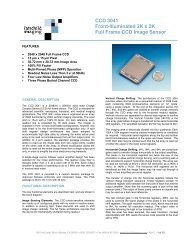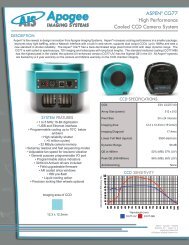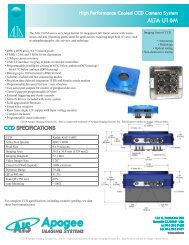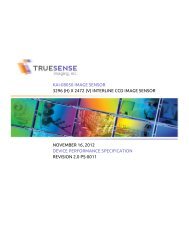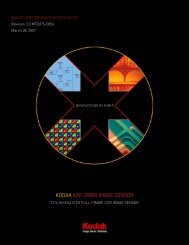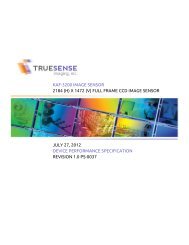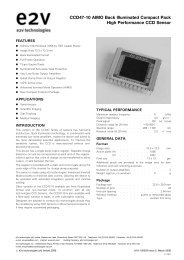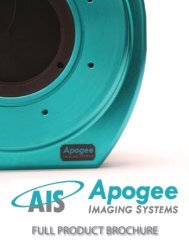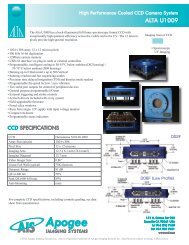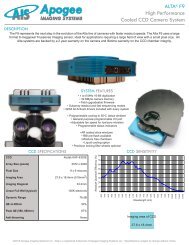OEM Support - Apogee Instruments, Inc.
OEM Support - Apogee Instruments, Inc.
OEM Support - Apogee Instruments, Inc.
You also want an ePaper? Increase the reach of your titles
YUMPU automatically turns print PDFs into web optimized ePapers that Google loves.
<strong>OEM</strong> <strong>Support</strong><br />
2011<br />
151 N. Sunrise Ste 902<br />
Roseville CA 95661 USA<br />
tel 916 218 7450<br />
fax 916 218 7451<br />
www.ccd.com<br />
Fluorescence image courtesy Dr. David Rapaport, UCSD; echelle spectra, courtesy<br />
Catalina Scientific; astro image courtesy Tim Puckett and Adam Block.
HIGH PERFORMANCE<br />
COOLED CCD CAMERAS<br />
SYSTEM OVERVIEW<br />
<strong>Apogee</strong> Alta and Ascent cameras are<br />
designed for a wide range of demanding<br />
scientific applications.<br />
In Ascent, we have reduced the size and<br />
cost of our electronics and housings, while at<br />
the same time maintaining the key features<br />
of our popular Alta Series cameras. We’ve<br />
added high-speed 16-bit electronics and<br />
some new sensors with resolutions up to 16<br />
megapixels.<br />
The larger Alta cameras offer lower noise<br />
and deeper cooling than the Ascent cameras.<br />
They also support very high quantum<br />
efficiency back-illuminated CCDs.<br />
For both camera series, the direct USB<br />
2.0 link between camera and computer allows<br />
easy installation, portability and fast data<br />
transfer rate. Ascent maintains compatibility<br />
with our Alta ActiveX drivers, as well as<br />
Linux and Mac OS X drivers.<br />
DIVERSITY ADDS STRENGTH<br />
Since 1993, <strong>Apogee</strong> Imaging Systems has<br />
been manufacturing cooled CCD cameras<br />
for scientific applications. Our cameras are<br />
now used in more than 50 countries, from<br />
government and private research laboratories<br />
to the best of world-class professional<br />
observatories. <strong>Apogee</strong> cameras have been<br />
used for a wide variety of applications,<br />
including spectroscopic analysis of water,<br />
soil, and gems; detection of anthrax;<br />
development of methods and technologies<br />
for detection of land mines and improvised<br />
explosive devices (IEDs); analysis and<br />
detection of contaminants at nuclear reactors;<br />
imaging of fingerprints without chemicals;<br />
x-ray inspection of car parts; fluorescent<br />
imaging of cell tissues and microtitre plates;<br />
munitions testing; laser beam profiling;<br />
poacher surveillance; mammography;<br />
optics testing; discovery of thousands of<br />
astronomical objects; and radiometry of a<br />
wide variety of light sources.<br />
By expanding into broad markets with<br />
diverse demands, <strong>Apogee</strong> has had to develop<br />
a wide variety of technologies to solve<br />
our customers’ problems. Our astronomy<br />
and spectroscopy customers demand low<br />
noise, high sensitivity, and high quantitative<br />
accuracy. Our life science customers demand<br />
speed and ease of use. All customers<br />
groups are constantly pushing for higher<br />
performance at lower prices. Ascent and Alta<br />
cameras address these demands.<br />
A DECADE OF<br />
IMPROVEMENTS<br />
We continue to refine not just our electronics<br />
and our mechanical designs, but also our<br />
procedures, documentation, and customer<br />
recordkeeping. It’s quite an accomplishment<br />
to manufacture and sell thousands and<br />
thousands of cameras, but unless they are<br />
robust, the result is a customer service<br />
nightmare.<br />
In our effort to improve our process, we’ve<br />
achieved the following benchmarks:<br />
· FCC compliance<br />
· CE compliance<br />
· ROHS compliance<br />
· ISO-9000 compliance (in process)<br />
INTEGRATION CD<br />
<strong>Apogee</strong> has collected all the specification<br />
sheets and mechanical drawings for all<br />
camera models onto an Integration Starter<br />
Kit CD, together with software drivers and<br />
documentation.<br />
<strong>Apogee</strong> Imaging Systems, <strong>Inc</strong>.<br />
151 N. Sunrise Ave. Ste 902<br />
Roseville CA 95661 USA<br />
tel 916 218 7450<br />
fax 916 218 7451<br />
www.ccd.com<br />
©2011 <strong>Apogee</strong> Imaging Systems <strong>Inc</strong>. Alta is a registered trademark of <strong>Apogee</strong> Imaging Systems <strong>Inc</strong>.<br />
Specifications subject to change without notice.
<strong>OEM</strong> SUPPORT<br />
<strong>OEM</strong> EVALUATION PROGRAM<br />
We can help you choose the right sensor for<br />
the job. If we do not already support the<br />
sensor that you need, we can discuss adding<br />
it to our product line. Once a sensor has been<br />
chosen, we provide <strong>OEM</strong> customers with a<br />
system for evaluation. The best way to feel<br />
confident that our systems are right for you:<br />
try one out.<br />
COST<br />
We supply the best price/performance in the<br />
industry. Researchers rely on <strong>Apogee</strong> to<br />
provide excellent value for their investment.<br />
<strong>OEM</strong>s rely on <strong>Apogee</strong> Imaging Systems to<br />
make their products more cost effective and<br />
competitive. Please contact our sales team<br />
for a quotation for any quantity, large or<br />
small. We make it easy for you to get started<br />
with us.<br />
BROAD SELECTION<br />
We offer a wide selection of CCDs, from<br />
interlines to full frame front-illuminated to<br />
back-illuminated, from 512 x 512 up to 4096<br />
x 4096. You can choose from a variety of<br />
sizes and shapes, from lowest cost to highest<br />
performance, knowing that you can build an<br />
entire product line around a single software<br />
integration.<br />
QUALITY<br />
Our goal is steady refinement in every<br />
aspect of the cameras, including product<br />
consistency, product lifetimes, rapid delivery,<br />
ease of adaptation and use, and added<br />
hardware and software features.<br />
EASE OF INTEGRATION<br />
All of our systems run on a single universal<br />
software driver. If you integrate control<br />
of one <strong>Apogee</strong> system into your custom<br />
software environment, you automatically<br />
have support for all of our systems. Based<br />
on the feedback we get from our customers,<br />
integration is simple and straightforward.<br />
CUSTOMIZATION<br />
<strong>Apogee</strong> Imaging Systems has a long history<br />
of working with <strong>OEM</strong> customers to modify<br />
our product line to fit their requirements.<br />
Perhaps you need to incorporate custom<br />
optical elements or to reduce the back focal<br />
distance of the camera. Let us know how we<br />
can optimize our cameras to best suit your<br />
application.<br />
AIDS TO INTEGRATION<br />
FACE PLATE ADAPTERS<br />
Flange adapters allow you to attach<br />
anything from an SLR camera lens to a large<br />
instrument pack to your <strong>Apogee</strong> camera. We<br />
have sizes to fit all Alta and Ascent cameras.<br />
These units are machined precisely for<br />
accurate concentricity.<br />
LENS & SLIP-FIT<br />
ADAPTERS<br />
We carry Nikon F-mount and Canon FD lens<br />
adapters, as well as slip-fit adapters.<br />
USB2 EXTENDERS<br />
www.ccd.com<br />
The new Icron USB 2.0 Ranger ® extenders<br />
support USB cameras at distances from 50<br />
meters (Cat 5 cable) to 10 km (fiber cable).
ASCENT versus ALTA SERIES CAMERAS<br />
There are many factors to consider when<br />
choosing a CCD camera: cost, resolution,<br />
speed, noise, cooling, sensitivity, housing<br />
size. Other features may contribute to a<br />
system’s overall suitability, but most of<br />
these features are shared by the Alta and<br />
Ascent. In general, consider the following<br />
key requirements to determine the optimal<br />
platform:<br />
Alta:<br />
Low readout noise<br />
Maximum cooling<br />
Back-illuminated CCDs<br />
Very large format CCDs<br />
Optional ethernet interface<br />
Ascent:<br />
Low cost<br />
High speed readout<br />
Compact housing<br />
LOWER COSTS<br />
Many applications require clean, quantitative<br />
images, but do not require the ultimate in<br />
cooling or low readout noise. The Ascent<br />
is an ideal solution for many applications<br />
where several thousand dollars may be more<br />
important than a few electrons.<br />
HIGHER THROUGHPUT<br />
Ascent was designed to operate at speeds<br />
up to the maximum allowed by USB2.<br />
Digitization speed is programmable so you<br />
can choose your ideal trade-off between<br />
speed and noise. All speeds digitize at a full<br />
16 bits.<br />
LOW READOUT NOISE<br />
Alta’s readout electronics were designed to<br />
minimize readout noise. The higher speed<br />
software-selectable 12-bit mode is intended<br />
for focussing, and not optimized for low<br />
noise.<br />
ADVANCED COOLING<br />
To maximize heat dissipation, Alta’s large<br />
inner chamber, back plate, and heatsinks are<br />
machined from a single block of aluminum.<br />
The four fans have four programmable<br />
speeds.<br />
BACK-ILLUMINATED CCDs<br />
Back-illuminated CCDs are much more<br />
expensive than front illuminated CCDs,<br />
so they are chosen when necessary for<br />
maximum signal-to-noise under low light<br />
conditions. Their higher dark current per<br />
square millimeter requires the higher cooling<br />
of larger Alta housing.<br />
VERY LARGE FORMAT CCDS<br />
The Alta platform is available in several<br />
housing sizes, accomodating CCDs up to<br />
50mm on a side.<br />
Dr. Nigel Woolf, University of California, San<br />
Diego won the second prize in the Nikon Small<br />
World 2001 contest with the <strong>Apogee</strong> KX85<br />
camera, the predecessor to the U2000.<br />
COMPACT HOUSING<br />
The Ascent’s smaller, more lightweight<br />
housing fits in many places that the larger<br />
Alta cannot.
ASCENT versus ALTA SERIES CAMERAS<br />
The primary differences between the Ascent and Alta Series cameras: Ascent is very compact with much lower costs, much faster<br />
digitization, and programmable gain. Alta is larger, with better cooling, and lower noise electronics. See the chart below for an<br />
overview of the differences. See camera data sheets to get details of a specific model.<br />
Feature Ascent Alta<br />
Digitization 16 bit, programmable speed Fast 12 and slower 16 bit<br />
Maximum throughput Up to 16 Mpixels/sec (Note 1) Up to 7 Mpixels/sec (Note 2)<br />
Dual channel interline readout Standard (on applicable CCDs) N/A<br />
Progressive scan for interlines<br />
Standard<br />
Video focus mode Standard N/A<br />
Maximum cooling 40C below ambient (Note 2) 70C below ambient (Note 2)<br />
Temperature regulation<br />
± 0.1°C<br />
Programmable gain & offset Standard N/A<br />
USB2 interface<br />
Standard<br />
Electromechanical shutter N/A Standard, internal (Note 3)<br />
Programmable fan speed N/A Standard<br />
Field upgradeable firmware<br />
Chamber window<br />
Peripheral communications<br />
General purpose I/O port<br />
Programmable LEDs<br />
Standard<br />
Fused silica<br />
8 pin mini-DIN connector<br />
Standard<br />
Standard<br />
Power input 6V 12V<br />
Internal memory<br />
32 Mbytes<br />
Types of CCDs supported Interline CCDs only Back- & Front-Illuminated; Interline<br />
External triggering<br />
Image sequences<br />
Hardware binning<br />
Subarray readout<br />
Standard<br />
up to 65535 images<br />
Up to 8 x height of CCD<br />
Standard<br />
TDI readout & Kinetics mode (Note 6) N/A Standard (See note 4)<br />
Back focal distance 0.32” (0.81 cm) 0.69” (17.5mm) and up (Note 2)<br />
C-mount interface (Note 7) Optional, external (Note 5) Standard for D01 & D03 housings<br />
Software universality<br />
Standard<br />
Housing size 4.8” x 3.25” x 2.25” 6” x 6” x 2.5” (Note 6)<br />
Warranty (Parts & labor)<br />
Warranty against condensation<br />
2 years<br />
Lifetime<br />
Note 1<br />
Note 2<br />
Note 3<br />
Note 4<br />
Note 5<br />
Note 6<br />
Maximum single channel throughput 12.5 MHz; dual channels at 8 megapixels/sec each<br />
Varies from model to model.<br />
Electromechanical shutters are standard for full frame CCDs, and optional for interline CCDs.<br />
Does not apply to interline CCDs.<br />
CCDs >1” video format are generally too large for C-mount optics.<br />
Some housings are larger.
ALTA & ASCENT: SHARED FEATURES<br />
TWO-YEAR WARRANTY<br />
All <strong>Apogee</strong> cameras have a standard two-year<br />
warranty and a lifetime guarantee against<br />
condensation in the camera.<br />
INTERNAL MEMORY<br />
32 Mbytes of SDRAM image memory is<br />
included in the Alta U Series and Ascent<br />
camera heads. Local memory serves some<br />
important functions:<br />
First, with some USB2.0 connections,<br />
consistency in download rates cannot be<br />
guaranteed. Some manufacturers go to great<br />
lengths to attempt to lock Windows ® up<br />
during downloads to ensure that no pattern<br />
noise results from breaks in the digitization<br />
process. The Alta and Ascent systems buffer<br />
the image transfer to protect from noiseproducing<br />
interruptions.<br />
Second, on heavily loaded USB2 ports<br />
and slower USB1.1 applications, the<br />
maximum digitization rate could be limited<br />
without a local buffer. Local image memory<br />
allows very fast digitization of image<br />
sequences up to the limit of the internal<br />
camera.<br />
HARDWARE BINNING<br />
Every Alta and Ascent camera supports<br />
hardware binning up to 8 in the horizontal<br />
direction and up to the height of the CCD in<br />
the vertical direction. Binning can be used<br />
to increase frame rate, dynamic range, or<br />
apparent sensitivity by collecting more light<br />
into a superpixel. See additional detail under<br />
CCD University on our website.<br />
SEALED INNER CHAMBERS<br />
The sensors for Alta and Ascent cameras are<br />
sealed into an inner chamber filled with inert<br />
gas. The chamber has a lifetime guarantee<br />
against condensation.<br />
PROGRAMMABLE LEDs<br />
Two LEDs on the side can be programmed<br />
to show status of a variety of the camera<br />
functions, such as the camera has reached<br />
the set temperature, the shutter is open, or<br />
the camera is waiting for an external trigger.<br />
Alternatively, the LEDs can be turned off if<br />
you are concerned about stray light.<br />
SOFTWARE<br />
An ActiveX driver is shipped with every Alta<br />
and Ascent camera. This driver is universal<br />
to all <strong>Apogee</strong> Alta and Ascent cameras, as<br />
well as legacy AP and KX cameras. If you<br />
write custom code for an <strong>Apogee</strong> camera, you<br />
won’t have to change it later if you change<br />
models. Our cameras are also supported by<br />
other programs like KestrelSpec. Linux and<br />
Mac OS X drivers are also available.<br />
UPGRADEABLE FIRMWARE<br />
The Alta and Ascent systems load all camera<br />
operating code on camera start. These<br />
configuration files can be updated via the web<br />
as we add features and make improvements.<br />
Each camera head has coded information<br />
identifying the type of system, its<br />
configuration, and type of CCD used, as well<br />
as the firmware revision in use. This allows<br />
automatic configuration of the camera in the<br />
field and better customer support from our<br />
offices.<br />
EXTERNAL TRIGGERING<br />
The Alta and Ascent camera systems accept<br />
external hardware trigger signals through<br />
their camera I/O ports for a number of<br />
purposes. Software and hardware triggers<br />
can be used together. For example, a software<br />
or hardware trigger may be used to initiate a<br />
single exposure or a sequence of exposures<br />
of a specific duration and specific delay<br />
between exposures. Alternatively, a software<br />
trigger may be used to start a sequence, and<br />
the external trigger can be used to trigger<br />
each subsequent image in the sequence.<br />
In addition, the external trigger can be<br />
used to trigger row shifts for time-delayed<br />
integration, or can be used to trigger block<br />
shifts for kinetic imaging.<br />
PROGRESSIVE SCAN<br />
(CONTINUOUS IMAGING)<br />
Interline transfer CCDs first shift charge<br />
from the photodiode in each pixel to the<br />
masked storage diode, and then march the<br />
charge through the storage diodes to the serial<br />
register. Acquisition of a new image in the<br />
photodiodes during readout of the previous<br />
image is called “progressive scan.” Alta and<br />
Ascent cameras both support progressive<br />
scan with interline CCDs.<br />
SUBARRAY READOUT<br />
Alta and Ascent cameras support readout<br />
of an arbitrary sub-section of the array in<br />
order to speed up frame rate. Reading half<br />
the array, for example, does not increase<br />
the frame rate by two because of overhead<br />
required in discarding unwanted pixels.<br />
Echelle Spectrograph Image of a Deuterium-<br />
Image courtesy of Prof. Dale Hunter, Tufts<br />
Tungsten Light Sourcea (Image courtesy<br />
University, MA<br />
Catalina Scientific Corporation) www.ccd.com Specifications subject to change without notice.
SPECIAL MODES OF OPERATION<br />
ALTA & ASCENT<br />
ALTA<br />
ALTA<br />
IMAGE SEQUENCES<br />
Image sequences of up to 65535 images<br />
can be acquired and transferred to camera /<br />
computer memory automatically. A delay<br />
may be programmed between images from<br />
327 microseconds to 21.43 seconds. (This<br />
does not mean you can acquire images every<br />
327 microseconds; it means you can program<br />
a delay of 327 microseconds between the<br />
end of a readout and the start of the next<br />
exposure.)<br />
The Ascent and Alta platforms allow for<br />
three types of image sequencing:<br />
Application-Driven Sequencing:<br />
This is the most common form of image<br />
sequencing. The application merely takes a<br />
specified number of successive images. This<br />
type of sequencing is suitable when the time<br />
between image acquisitions is not short and<br />
where slight differences in timing from image<br />
to image are not important.<br />
Precision back to back sequencing<br />
Alta and Ascent incorporate a firmware<br />
controlled back to back image sequencing<br />
mode suitable for image-image intervals from<br />
327uS to a maximum of 21.43 seconds in<br />
327uS intervals. This provides for precision<br />
spacing of images in a sequence where<br />
windows applications cannot respond.<br />
Fast back to back sequencing (Ratio<br />
Imaging - Interlines only)<br />
This is a special form of precision back to<br />
back sequencing designed for a fixed
ALTA SERIES CAMERAS: 0VERVIEW<br />
ADVANCED COOLING<br />
The <strong>Apogee</strong> cooling system has long been<br />
one of the most advanced in the industry.<br />
The Alta control system has been expanded<br />
to 12 bits, allowing a temperature control<br />
range of 213K to 313K (-60 to +40 C)<br />
with 0.024 degree resolution. Sensors<br />
have been added to monitor the heat sink<br />
temperature. A power indicator has been<br />
added to give the user an idea of how much<br />
drive is being given to the CCD cooler. The<br />
automatic back-off function is now handled<br />
by the firmware and driver. If the system<br />
cannot reach the desired temperature, the<br />
system automatically backs off to a point<br />
where regulation can be maintained, 2<br />
degrees above the maximum temperature<br />
reached. The new set point is given to the<br />
user. Cooling deltas of 40-60C (depending<br />
on sensor area) are typical with simple air<br />
cooling.<br />
CABLE LENGTH<br />
USB2 cables are limited to 5m between<br />
hubs, with up to 5 hubs, for a total of 30m.<br />
However, there are USB2 extenders available<br />
for Cat5 or fiber optic cable, for operation up<br />
to 10 km.<br />
PROGRAMMABLE FANS<br />
Some customers require a complete absence<br />
of vibration during an exposure. The Alta<br />
systems have been designed for complete<br />
control of the cooling fans. The fans may be<br />
turned off, or run at a much slower speed to<br />
maintain adequate cooling with no vibration.<br />
For applications where vibration is not an<br />
issue, the fan speed may be maximized for<br />
greatest cooling. The fans used in the Alta<br />
system were selected for minimum<br />
vibration.<br />
DUAL DIGITIZATION<br />
With our fast USB2 systems, we offer dual<br />
digitization: high precision, low noise 16 bit<br />
performance as well as high speed 12 bit for<br />
focussing and other high frame rate needs.<br />
Digitization depth is selectable image by<br />
image in software<br />
MGF2 COATED<br />
FUSED SILICA OPTICS<br />
Professional grade details like magnesiumflouride<br />
coated fused silica windows. <strong>Apogee</strong><br />
also offers custom windows, including wedge<br />
windows and customer supplied optics.<br />
SINGLE 12V POWER SUPPLY<br />
Alta camera systems include a 12V<br />
international power supply (100V-240V<br />
input), but can be operated from a clean 12V<br />
source.<br />
LIQUID CIRCULATION<br />
D02 and D01 housings<br />
HOUSING OPTIONS<br />
Alta cameras with small format CCDs have<br />
a 0.69” (17.5 mm) C-mount back focal<br />
distance for direct interface to microscopes<br />
and C-mount lenses. Medium format sensors<br />
use the D02 housing with 2” thread. Large<br />
format sensors use the D07 housing with a<br />
2.5” thread. Back focal distance for the D02<br />
and D07 housing is approximately 1.04”<br />
(26.4 mm). All cameras have a bolt circle<br />
with metric threads for adaptation to a wide<br />
variety of flanges.<br />
OPTIONAL WIDE ENTRANCE<br />
ANGLE HOUSINGS<br />
Housings with wide entrance angles are<br />
available for most medium and large format<br />
CCDs. See the section on Housings for<br />
additional details.<br />
OPTIONAL LOW PROFILE<br />
HOUSINGS<br />
Lower profile housings are available for all<br />
Alta models to achieve
ALTA SERIES CAMERAS: 0VERVIEW<br />
SHUTTERS<br />
<strong>Apogee</strong> Imaging Systems uses the finest<br />
shutters available for our cameras from<br />
Vincent and Melles Griot. These shutters<br />
have been carefully integrated into our<br />
camera heads with minimum impact on<br />
back focal distance and camera size. These<br />
shutters have a huge advantage over simple<br />
rotating blade shutters in terms of light<br />
blockage and minimum exposure time.<br />
GENERAL I/O PORT FOR ALTA & ASCENT<br />
Our general purpose I/O port can tell you<br />
when the shutter is open, or can be used for<br />
a wide variety of external trigger inputs,<br />
including line-by-line control of TDI shifts.<br />
Alta cameras use three shutter types,<br />
depending on the aperture. <strong>Apogee</strong> shutters<br />
use lower voltage coils then those listed<br />
as standard by the shutter manufacturers,<br />
roughly 1/2 of the standard voltage<br />
requirement. The lower voltages extend the<br />
lifetimes of the shutters.<br />
D01 housing, small format sensors:<br />
Vincent Uniblitz 25mm Shutter<br />
D02 housing, medium format sensors:<br />
Melles Griot 43mm Shutter<br />
D07 and D09 housings, large format sensors:<br />
Melles Griot 63.5mm Shutter<br />
Full frame CCDs typically require an<br />
electromechanical shutter unless the light<br />
source is gated in some other way. Otherwise<br />
light falling on the sensor during the readout<br />
process corrupts the image. Interline<br />
CCDs shift the charge from the photodiode<br />
section of each pixel to the masked storage<br />
diode. For low light applications, the mask<br />
is sufficiently opaque to prevent smearing.<br />
However, in high light applications, interline<br />
CCDs require electromechanical shutters to<br />
prevent smearing during readout.<br />
Specifications subject to change without notice.<br />
www.ccd.com<br />
M27 by Don Goldman, using Alta U16M camera
ASCENT SERIES CAMERAS: 0VERVIEW<br />
PROGRAMMABLE DIGITIZATION<br />
Unlike previous generations of <strong>Apogee</strong><br />
cameras with fixed digitization rates for<br />
each bit depth, the Ascent cameras feature<br />
programmable readout rates using 16-bit<br />
digitization. You can choose the best tradeoff<br />
between noise and readout speed imageby-image.<br />
Some CCDs, like the Kodak<br />
interline transfers, can read two channels at<br />
up to 8 MHz each, for a total throughput of<br />
16 megapixels per second. Other CCDs, like<br />
the Sonys, typically have a single channel<br />
maximum throughput rate of 12.5 MHz. See<br />
individual camera data sheets for specifics<br />
regarding each camera system.<br />
PROGRAMMABLE GAIN AND<br />
OFFSET<br />
All Ascent models feature programmable<br />
gain and bias offset programmable in the<br />
analog-to-digital converter.<br />
ANTI-REFLECTIVE COATED<br />
FUSED SILICA OPTICS<br />
The standard chamber window for the Ascent<br />
system is fused silica.<br />
SINGLE 6V POWER SUPPLY<br />
Ascent camera systems include a 6V<br />
international power supply (100V-240V<br />
input), but can be operated from a clean 6V<br />
source.<br />
COMPACT DESIGN<br />
The Ascent systems are extremely<br />
lightweight (0.65 kg) and compact. At 4.7” x<br />
3.2” (11.9 x 8.1 cm) and only 1.3” (3.3 cm)<br />
thick with no external electronics, the Ascent<br />
is a marvel of compact electronics. The<br />
standard back focal distance for all models is<br />
about 0.32” (0.8 cm).<br />
Model CCD* Array Pixels Pixel size<br />
(microns)<br />
ASCENT FILTER WHEEL<br />
Ascent filter wheels are available for<br />
6-positions for 1” (25mm) filters or 8-position<br />
for 1.25” (31mm) filters (shown with optional<br />
Nikon F-mount lens adapter).<br />
ASCENT MODELS (ALL CCDs ARE INTERLINE TRANSFER)<br />
CCD Size<br />
(mm)<br />
Area<br />
(mm2)<br />
Diagonal<br />
(mm)<br />
Video<br />
size (“)<br />
A340 KAI-0340 684 x 484 313K 7.4 4.8 x 3.6 17.2 6.0 0.37<br />
A1050 KAI-1050 1024 x 1024 1.1M 5.5 5.6 x 5.6 34.8 8.3 0.52<br />
A2050 KAI-2050 1600 x 1200 1.9M 5.5 8.8 x 6.6 58.1 11.0 0.69<br />
A2150 KAI-2150 1920 x 1080 2.1M 5.5 10.6 x 5.9 62.7 12.1 0.76<br />
A2000 KAI-2020 1600 x 1200 1.9M 7.4 11.8 x 8.9 105.1 14.8 0.93<br />
A4050 KAI-4050 2336 x 1752 4.2M 5.5 11.3 x 11.3 126.9 15.9 1.0<br />
A4000 KAI-4022 2048 x 2048 4.2M 7.4 15.2 x 15.2 229.7 21.4 1.34<br />
A8050 KAI-8050 3296 x 2472 8.1M 5.5 18.1 x 13.6 246.5 22.7 1.42<br />
A16000 KAI-16000 4872 x 3248 15.8M 7.4 36 x 24 866.5 43.3 2.7<br />
A205 ICX205 1360 x 1024 1.4M 4.65 6.3 x 4.8 30.1 7.9 0.49<br />
A285 ICX285 1360 x 1024 1.4M 6.45 8.8 x 6.6 57.9 11.0 0.69<br />
* KAI = Kodak and ICX = Sony. For complete CCD specifications, including cosmetic grading, see data sheet from manufacturer.
ALTA CCD SELECTION<br />
In addition to the following CCDs, the Alta Series supports a variety of spectroscopic format back-illuminated CCDs listed on a<br />
following page.<br />
Camera<br />
Model E2V CCD Array Size<br />
Total<br />
Pixels<br />
Pixel Size<br />
(microns)<br />
INTERLINE TRANSFER CCDs<br />
Array size (mm)<br />
X<br />
Y<br />
Imaging Area<br />
(mm2)<br />
Diagonal<br />
(mm)<br />
U42 CCD42-40 2048 2048 4194304 13.5 27.6 27.6 764 39.1<br />
U230 CCD230-42 2048 2048 4194304 15 30.7 30.7 944 43.4<br />
U3041 Fairchild 3041 2048 2048 4194304 15 30.7 30.7 944 43.4<br />
U47 CCD47-10 1024 1024 1048576 13 13.3 13.3 177 18.8<br />
U77 CCD77-00 512 512 262144 24 12.3 12.3 151 17.4<br />
U30 CCD30-11 1024 256 262144 26 26.6 6.7 177 27.4<br />
Camera<br />
Model Kodak CCD* Array Size<br />
FRONT-ILLUMINATED CCDs<br />
Total<br />
Pixels<br />
Pixel Size<br />
(microns)<br />
Array size (mm)<br />
X<br />
Y<br />
Imaging Area<br />
(mm2)<br />
Diagonal<br />
(mm)<br />
Mono=M<br />
Color=C<br />
U39000 KAF-39000 7216 5412 39052992 6..8 49.1 36.8 1806 61.3 M,C<br />
U16 KAF-16801E 4096 4096 16777216 9 36.9 36.9 1359.0 52.1 M<br />
U16M KAF-16803 4096 4096 16777216 9 36.9 36.9 1359.0 52.1 M<br />
U9000 KAF-09000 3058 3058 9351364 12 36.7 36.7 1346.6 51.9 M<br />
U8300 KAF-8300CE 3448 2574 8875152 5.4 18.6 13.9 259 23.2 M,C<br />
U9 KAF-6303E 3072 2048 6291456 9 27.6 18.4 509.6 33.2 M<br />
U43 KAF-4320E 2048 2048 4194304 24 49.1 49.1 2415 69.5 M<br />
U3041F Fairchild 3041 2048 2048 4194304 15 30.7 30.7 944 43.4 M<br />
U10 TH7899* 2048 2048 4194304 14 28.7 28.7 822.1 40.6 M<br />
U32 KAF-3200 2184 1472 3214848 6.8 14.9 10.0 148.7 17.9 M<br />
U2 KAF-1603ME 1536 1024 1572864 9 13.8 9.2 127.4 16.6 M<br />
U6 KAF-1001E 1024 1024 1048576 24 24.6 24.6 604.0 34.8 M<br />
U1 KAF-0402ME 768 512 393216 9 6.9 4.6 31.9 8.3 M<br />
U260 KAF-0261E 512 512 262144 20 10.2 10.2 104.9 14.5 M<br />
U30-OE CCD30-11 1024 256 262144 26 26.6 6.7 177 27.4 M<br />
Camera<br />
Model* Kodak CCD Array Size<br />
BACK-ILLUMINATED CCDs<br />
*The U10 uses an E2V (formerly Atmel, formerly Thomson) TH7899 CCD.<br />
Total<br />
Pixels<br />
Pixel Size<br />
(microns)<br />
Array size (mm)<br />
X<br />
Y<br />
Imaging Area<br />
(mm2)<br />
Diagonal<br />
(mm)<br />
Mono=M<br />
Color=C<br />
U16000 KAI-16000 4872 3248 15824256 7.4 36 24 866.5 43.3 M,C<br />
U4000 KAI-4022 2048 2048 4194304 7.4 15.2 15.2 229.7 21.4 M,C<br />
U2000 KAI-2020 1600 1200 1920000 7.4 11.8 8.9 105.1 14.8 M,C<br />
Specifications subject to change without notice.<br />
www.ccd.com
CCD SELECTION<br />
CCD SIZES (ACTUAL SIZE)<br />
BACK-ILLUMINATED<br />
<strong>Apogee</strong> also offers a variety of spectroscopic<br />
format back-illuminateed CCDs.<br />
U230<br />
U3041<br />
2048 x 2048<br />
15 micron pixels<br />
U42<br />
QUANTUM EFFICIENCY<br />
The QE curves below give general representations of the relative differences between the<br />
various types of CCDs. For additional detail, please see the data sheets for each camera<br />
model at www.ccd.com. QE of back-illuminated CCDs depends on the coating (midband,<br />
broadband, UV-enhanced). There are also variations in front-illuminated CCDs: all<br />
polysilicon gates; Blue Plus (polysilicon and indium tin oxide gates); microlenses; antiblooming.<br />
See individual camera data sheets for details regarding each sensor.<br />
E2V: BACK-ILLUMINATED & OPEN ELECTRODE CCDs<br />
U30<br />
U47<br />
U77<br />
FRONT-ILLUMINATED<br />
U43<br />
2048 x 2048<br />
24 micron pixels<br />
U260<br />
U1<br />
U2<br />
U32<br />
U16<br />
U16M<br />
U9000<br />
U10<br />
INTERLINES<br />
U16000<br />
U8300<br />
U6<br />
U9<br />
U30-OE<br />
U4000<br />
Quantum efficiency (%)<br />
100<br />
90<br />
80<br />
70<br />
60<br />
50<br />
40<br />
30<br />
20<br />
10<br />
0<br />
FRONT-ILLUMINATED CCDs<br />
CCDs in red also available as color.<br />
U2000<br />
Wavelength (nm)<br />
A205 Kodak E Kodak ME A285 U2000
CCD SELECTION<br />
Camera<br />
Model<br />
These back-illuminated CCD systems set a new standard for low-cost spectroscopic systems. (Monochrome only)<br />
Hamamatsu<br />
CCD<br />
HAMAMATSU: BACK-ILLUMINATED SPECTROSCOPIC FORMAT CCDs<br />
Array Size<br />
Total<br />
Pixels<br />
Pixel Size<br />
(microns)<br />
Array size (mm)<br />
X<br />
Y<br />
Imaging Area<br />
(mm2)<br />
Diagonal<br />
(mm)<br />
U1109 S10140-1109 2048 506 1036288 12 24.6 6.1 149.2 25.3<br />
U1108 S10140-1108 1024 250 512000 12 24.6 3.0 73.7 24.8<br />
U1107 S10140-1107 512 122 249856 12 24.6 1.5 36.0 24.6<br />
U1009 S10140-1009 1024 506 518144 12 12.3 6.1 74.6 13.7<br />
U1008 S10140-1008 1024 250 256000 12 12.3 3.0 36.9 12.6<br />
U1007 S10140-1007 1024 122 124928 12 12.3 1.5 18.0 12.4<br />
U98 S9840 2048 14 28672 14 28.7 0.2 5.6 28.7<br />
Absolute Quantum Efficiency (%)<br />
100<br />
90<br />
80<br />
70<br />
60<br />
50<br />
40<br />
30<br />
20<br />
10<br />
0<br />
200<br />
240<br />
280<br />
320<br />
360<br />
400<br />
440<br />
480<br />
520<br />
560<br />
600<br />
640<br />
680<br />
720<br />
760<br />
800<br />
840<br />
880<br />
920<br />
960<br />
1000<br />
1040<br />
1080<br />
Wavelength (nm)<br />
80<br />
KODAK VERY LARGE FORMATS: KAF-16803 & KAF-09000<br />
70<br />
Absolute Quantum Efficiency (%)<br />
60<br />
50<br />
40<br />
30<br />
20<br />
10<br />
0<br />
360 380 400 420 440 460 480 500 520 540 560 580 600 620 640 660 680 700 720 740 760 780 800 820 840 860 880 900 920 940 960 980 1000 1020 1040 1060 1080 1100<br />
Wavelength (nm)<br />
Kodak KAF-09000<br />
Kodak KAF-16803
CCD SELECTION<br />
CCDs come in many shapes and sizes, as<br />
well as several different architectures.<br />
Some architectures were developed<br />
specifically to address the needs of extremely<br />
low light applications like astronomy (backilluminated<br />
CCDs). Other technologies<br />
can be adapted to astronomy with excellent<br />
results, but a bit more patience and diligence<br />
may be necessary (interline transfer CCDs).<br />
Here are some ideas to keep in mind:<br />
QUANTUM EFFICIENCY<br />
Higher sensitivity = higher quantum<br />
efficiency = shorter exposures to get the<br />
same results. Shorter exposures = more time<br />
for other exposures and less frustration with<br />
guiding and tracking. The peak value of a<br />
quantum effiiciency curve does not tell the<br />
full story of a CCD’s sensitivity. The area<br />
under the curve gives the true comparison of<br />
a CCD’s relative sensitivity. Twice the area<br />
under the curve = half the time making the<br />
exposure. Or, use the same exposure time,<br />
but get twice the signal. <strong>Apogee</strong> supports<br />
back-illuminated, front-illuminated, and<br />
interline transfer devices. Back-illuminated<br />
CCDs have the highest overall sensitivity.<br />
However, they are subject to etaloning (aka<br />
“fringing”) in the near-infrared. Frontilluminated<br />
CCDs are much less expensive<br />
than back-illuminated CCDs. Make your<br />
own choices regarding the Biggest Bang for<br />
the Buck.<br />
UV & NIR WAVELENGTHS<br />
Between 200-300 nm: E2V Back-illuminated<br />
UV enhanced CCDs<br />
Between 300-400 nm: most Kodak CCDs<br />
have zero QE at 300 nm, increasing linearly<br />
to >40% at 400 nm.<br />
Near Infrared: Back-illuminated CCDs have<br />
the highest QE, but they are also subject to<br />
fringing (also known as “etaloning”) with<br />
monochromatic NIR (simply put, the light<br />
bounces around inside the CCD itself). Some<br />
companies have developed proprietary versions<br />
of CCDs that minimize, though not<br />
eliminate, the effect by changing the thickness<br />
of the CCD itself.<br />
www.ccd.com<br />
PIXEL SIZE<br />
The smaller the pixel, the lower the signal<br />
that can be stored in the pixel (“full well<br />
capacity”). If the noise per pixel is the same<br />
for two cameras, lower full well means lower<br />
signal-to-noise, or compromised image<br />
quality. Such a compromise is hard to see<br />
when doing bright field imaging. But when<br />
doing low light imaging, higher signal to<br />
noise means pulling out those faint elements<br />
without making the bright areas into a burned<br />
white blob.<br />
In many cases, using a smaller pixel in<br />
order to obtain higher pixel resolution is<br />
actually dysfunctional. For example, in the<br />
field of microscopy, pixels smaller than 6<br />
microns do not provide additional spatial<br />
information. At only 4X magnification,<br />
with a numerical aperture of 0.1 and a<br />
wavelength of 550 nm (green), the limit to<br />
practical resolution is about a 3.65 micron<br />
feature. Such a feature maps to 14.6 microns<br />
on the CCD. Nyquist sampling requires<br />
oversampling by a factor of 2 in order to<br />
accurately reconstruct the signal. Thus, a<br />
7.3 micron pixel is small enough to gather<br />
all the spatial information provided by the<br />
microscope. As magnification is increased,<br />
the required size for the pixel also increases.<br />
Pixels in the range of 6 to 8 microns are<br />
the ideal match for microscopy, storing<br />
maximum signal without compromising<br />
spatial sampling.<br />
Image: Gary McAnally, <strong>Apogee</strong> Imaging<br />
Systems. Slide courtesy of Chroma.<br />
COLOR CCDS<br />
Color CCDs are convenient for one-shot<br />
color, but they compromise in several ways.<br />
First, the typical red-green-blue (RGB) Bayer<br />
pattern over the pixels of the CCD (see<br />
below) cannot be changed--you cannot do<br />
monochromatic imaging one day, RGB the<br />
next, and cyan-magenta-yellow (CMY) on<br />
the third. Second, color CCDs cannot deliver<br />
the full resolution of the imager. They can,<br />
however, deliver all three color channels at<br />
exactly the same instant in time.<br />
Typical RGB Bayer filter pattern designed to<br />
mimic the responsivity of the human eye.<br />
Quantum efficiency of the Kodak KAI-16000<br />
CCD: black line is monomchrome version;<br />
RGB lines are the color version.<br />
DYNAMIC RANGE<br />
Interline transfer CCDs have, at most, a<br />
full well capacity of about 50K electrons. If<br />
the electronics limits the read noise to 8-10<br />
electrons, this is a dynamic range of 50K/10<br />
= 5000:1, or about 12.3 bits. Most argue for<br />
oversampling by an extra bit, or some argue<br />
even two. However, a 16-bit analog-todigital<br />
(AtoD) converter does not upgrade a<br />
12 bit imager into a 16 bit imager. A Kodak<br />
KAF-1001E (Alta U6 camera), using the low<br />
noise (aka high gain) output amplifier, can be<br />
operated at 6 electrons noise with a full well<br />
of 200K electrons, or a dynamic range of<br />
more than 30K:1, about 15 bits.<br />
Specifications subject to change without notice.
CCD SELECTION<br />
INTERLINE TRANSFER CCDs<br />
Interline transfer CCDs, up to the scale of<br />
35mm film, have inherent anti-blooming,<br />
but less dynamic range and lower quantum<br />
efficiency than Kodak’s other frontilluminated<br />
offerings. Interlines also have<br />
high dark current in the storage diodes, as<br />
well as some leakage through the storage<br />
diode masks. Mass markets for interline<br />
CCDs mean much lower prices per pixel,<br />
and a great entry point into professional level<br />
imaging.<br />
Because interline CCDs shutter the<br />
exposure by shifting the charge from the<br />
photodiode section of the pixel to the storage<br />
diode of the pixel, exposure times can be as<br />
short as a few microseconds. Time between<br />
exposures is determined by the time required<br />
to read out the entire CCD, which varies from<br />
camera to camera.<br />
Interline transfer CCDs cannot do timedelayed<br />
integration (also known as “drift<br />
scan” mode) because charge is not transferred<br />
from photodiode to photodiode, but rather<br />
into the masked storage diode.<br />
DARK CURRENT<br />
Thermally generated signal, or dark current,<br />
is not noise. The shot noise component of the<br />
dark current is one element of noise, which<br />
is the square root of the dark current. You<br />
can correct for the dark current itself if you<br />
can measure it, which requires the camera’s<br />
cooling to be programmable and stable. The<br />
deeper the cooling, the less correction you’re<br />
going to have to do.<br />
E2V CCDs: AIMO & NIMO<br />
E2V’s AIMO (Advanced I Metal Oxide, aka<br />
MPP) CCDs have hundreds of times less<br />
dark current than non-IMO (NIMO) CCDs.<br />
Some variations of their CCDs, such as deep<br />
depletion devices with high QE in the near<br />
IR, are only available as NIMO devices.<br />
Specifications subject to change without notice.<br />
CCD GRADES<br />
Each manufacturer’s specification sheet for<br />
an imager defines the cosmetic grades for<br />
that specific imager. Different manufacturers<br />
use different procedures; a grade 1 of Imager<br />
A may allow column defects, but a grade 2<br />
(lower grade) of Imager B may not. Kodak<br />
usually grades their CCDs at about 25°C,<br />
and most of their defects disappear in cooled<br />
cameras when the images are flat-fielded. In<br />
most cases, you cannot see the difference<br />
between the grades. Other companies,<br />
such as E2V, grade their CCDs at low<br />
temperatures, so their defects are less likely<br />
to disappear when the CCD is cooled.<br />
Defects on CCDs do not grow over time,<br />
nor do lower grade CCDs wear out faster.<br />
Most lower grade Kodak CCDs no longer<br />
allow column defects. These lower priced<br />
CCDs are excellent bargains.<br />
You may get an unwanted surprise if you<br />
do not check the data sheets for each CCD<br />
carefully before purchasing a system. Some<br />
large format CCDs allow several column<br />
defects in the “standard grade” CCD,<br />
ANTI-BLOOMING<br />
Anti-blooming (AB) bleeds off excess charge<br />
from individual pixels so that it does not spill<br />
over into its neighbors and cause a white<br />
stripe down the column. For applications like<br />
astrophotography, AB preserves the aesthetics<br />
of the image. For photometric applications,<br />
AB can be used if exposure times are<br />
carefully controlled to avoid excess charge.<br />
The disadvantages of AB: normally it lowers<br />
full well capacity and quantum efficiency.<br />
SPECSMANSHIP<br />
CCD manufacturers as well as camera<br />
manufacturers both describe their products<br />
in terms of typical performance, and in some<br />
cases, specify worst acceptable performance.<br />
A CCD data sheet may, for example, say<br />
“typical 15 electrons noise” and “maximum<br />
20 electrons noise” (under very specific<br />
and perhaps irrelevant conditions). As a<br />
result, camera manufacturers using such a<br />
CCD must also use “typical performance”,<br />
or sort CCDs at a potentially large increase<br />
in cost. The difference between typical and<br />
guaranteed is sometimes large, such as a<br />
factor of two in dark current.<br />
KODAK BLUE PLUS CCDs<br />
CCDs create charge due to the photoelectric<br />
effect. In order to create an image rather<br />
than random electricity, the charge must be<br />
held where it was created. “Traditional”<br />
CCDs using from one to four polysilicon<br />
gates carry a voltage that traps the charge<br />
until transferred. Polysilicon has limited<br />
transmissivity. Indium tin oxide (ITO) gates<br />
have higher transmissivity, but lower charge<br />
transfer efficiency. Kodak’s combination<br />
of one polysilicon gate and one ITO gate<br />
is marketed as Blue Plus (because of the<br />
increase in blue sensitivity). The overall<br />
sensitivity of Blue Plus CCDs is much higher<br />
than multi-phase front-illuminated CCDs<br />
using only polysilicon gates. However,<br />
when researching point sources of light, it is<br />
good to keep in mind that there is a marked<br />
increase in quantum effiiency on the ITO side<br />
of each pixel. (See MICROLENSES below).<br />
MICROLENSED CCDs<br />
Many CCDs now use microlenses over<br />
each pixel. In the case of interline transfer<br />
CCDs, the microlenses focus the light onto<br />
the photodiode. In the case of Blue Plus<br />
CCDs (see above), the microlenses focus<br />
the light onto the ITO gate side of the pixel.<br />
Microlenses greatly improve overall quantum<br />
efficiency, but introduce some angular<br />
dependency. Fill factor is normally less than<br />
100%. See data sheets for individual CCDs<br />
for details.<br />
www.ccd.com
THANKS (A PARTIAL LIST OF APOGEE IMAGING SYSTEMS CUSTOMERS)<br />
<strong>Apogee</strong> Imaging Systems would like to express our gratitude to the thousands of customers from around the world<br />
that have brought so much to our lives since 1994.<br />
Aerospace Corporation • Air Force Research Laboratory • Aloe Ridge Observatory (South Africa) • American Red Cross • Anglo-Australian<br />
Observatory • Ankara University Observatory (Turkey) • Apache Point Observatory • Appalachian State University • Argonne National Laboratory<br />
• Astronomical Institute of the Czech Republic • Astronomical Observatory Belgrade (Yugoslavia) • Astrophysical Observatory, College of<br />
Staten Island • Auckland Observatory (New Zealand) • Bacs-Kiskun Observatory (Hungary) • Baja Astronomical Observatory (Hungary) • Ball<br />
Aerospace • Bang & Olufsen (Denmark) • Baton Rouge Observatory • Baylor University • Bechtel • Beijing Observatory (China) • Big Bear Solar<br />
Observatory • Boeing • Bohyunsan Optical Astronomy Observatory (Korea) • Boston University • Brigham Young University • California Institute<br />
of Technology • Centre National de la Recherche Scientifique (France) • Centro de Investigaciones en Optica (México) • Chiang Mai University<br />
(Thailand) • Chiba University (Japan) • Chinese University of Hong Kong • Clemson University • Colorado School of Mines • Columbia University<br />
• Complejo Astronómico El Leoncito (Argentina) • Copenhagen University (Denmark) • Cork Institute of Technology (Ireland) • Corning • Crimean<br />
Astrophysical Observatory (Ukraine) • Czech Technical University (Czech Republic) • Daimler Benz Aerospace (Germany) • Department of National<br />
Defence, Canada • DLR e.V. (Germany) • Dublin Institute for Advanced Studies, Dunsink Observatory (Ireland) • Dworp Observatory (Belgium)<br />
• Eastman Kodak • Ege University (Turkey) • Florida Institute of Technology / SARA • Ford Motor • Fox Chase Cancer Center • Fudan University<br />
(China) • Fuji • Fujitsu • Gemini Telescope Project • Gøteburg University (Sweden) • Harvard-Smithsonian Center for Astrophysics • Harvard<br />
College Observatory • Heron Cove Observatory • Hida Observatory (Japan) • High Energy Accelerator Research Organization (Japan) • High<br />
Frequency Active Auroral Research Program (HAARP) • Hiroshima University (Japan) • Hitachi • Hong Kong University of Science & Technology<br />
• Imation • Indian Institute of Astrophysics • Industrial Technology Research Institute (ITRI) (Taiwan) • Institute for Astronomy, Hawaii • Institute of<br />
Astronomy (Switzerland) • Institute of Astronomy and Astrophysics (Taiwan) • Institute of Atomic and Molecular Sciences (Taiwan) • Institute for<br />
Quantum Physics (Switzerland) • Instituto de Astrofisica de Andalucia (Spain) • Instituto de Astrofisica de Canarias (Spain) • Inst. Estudis Espacials<br />
de Catalunya (Spain) • International Science & Technology Centre (Russia) • IVIC-CBB (Venezuela) • J.Paul Getty Museum • Jagellonian University<br />
(Poland) • Japan Atomic Energy Agency • Jet Propulsion Laboratory • Johns Hopkins University • Kimberly-Clark • Kim-Hae Observatory (Korea)<br />
• Kitt Peak National Observatory • Konkoly Observatory (Hungary) • Korea Astronomical Observatory • Korea Research Institute of Standards<br />
and Science • Kwasan Observatory (Japan) • Kyoto University (Japan) • Lancaster University (UK) • Landessternwarte Heidelberg-Königstuhl<br />
(Germany) • Las Cumbres Observatory • Lawrence Berkeley National Laboratory • Lawrence Livermore National Laboratory • Lick Observatory<br />
• Liverpool John Moores University (UK) • Lockheed Martin • London Health Sciences Centre (Canada) • Los Alamos National Laboratory •<br />
Lucent Technologies • Lund Observatory (Sweden) • Mauna Loa Observatory • Max Planck Institute (Germany) • McGill University (Canada) •<br />
MIT • MIT Lincoln Laboratory • Mt. Cuba Astronomical Observatory • Mt. Diablo Observatory • Mt. Stromlo Observatory (Australia) • Mt. Wilson<br />
Observatory • Multiple Mirror Telescope • Nagoya University (Japan) • NASA Goddard SFC • NASA Marshall SFC • NASA Langley Research<br />
Center • National Astronomical Observatory (Japan) • National Central University (Taiwan) • National Cheng Kung University (Taiwan) • National<br />
Health Research (Taiwan) • National Institute for Advanced Interdisciplinary Research (Japan) • National Institute of Advanced Industrial Science<br />
and Technology (Japan) • National Institute for Materials Science (Japan) • National Institute of Standards & Technology • National Oceanographic<br />
and Atmospheric Administration • National Solar Observatory • National Sun Yat-Sen University (Taiwan) • National Tsing Hua University (Taiwan)<br />
• National University of Ireland • Naval Post Graduate School • Naval Research Laboratory • Northwestern University • NTT (Japan) • Oak Ridge<br />
National Laboratory • Observatoire Côte d’Azur (France) • Observatoire de Geneve (Switzerland) • Observatorio “Carl Sagan” (Mexico) • Occidental<br />
College • Okayama Astrophysical Observatory (Japan) • Oxford University (UK) • Osaka University (Japan) • Oulu University (Finland) • Panasonic<br />
• Physical Research Laboratory (India) • Police Scientific Development Branch, Scotland Yard (UK) • Pomona College • Portland State University<br />
• Princeton University • Purdue University • Purple Mountain Observatory (China) • Queens University (Canada) • Rice University • Riken (Japan)<br />
• Rockefeller University • Royal Military College of Canada • Royal Observatory (Edinburgh, Scotland) • Russian Academy of Sciences • Sandia<br />
National Laboratory • Science and Technology Centre of Ukraine • Shamakhy Astrophysical Observatory (Azerbaijan) • Smithsonian Observatory •<br />
South African Astronomical Observatory • Stanford University • State Universities of Arizona, Georgia, Iowa, Louisiana, Michigan, Montana, New<br />
York (SUNY), North Carolina, Ohio, Pennsylvania, Tennessee, and Texas • Stanford University • Starkenburg Observatory (Germany) • Sternberg<br />
Astronomical Observatory (Russia) • Steward Observatory • Stockholm Observatory (Sweden) • Subaru Telescope • Swarthmore College • Tel<br />
Aviv University • Temple End Observatory (UK) • Tenagra Observatories • Texas A&M University • Texas Tech University • Tokyo Institute of<br />
Technology • Tokyo University • Toshiba • Tuorla Observatory (Finland) • Turku Centre for Biotechnology (Finland) • Universidad de Buenos Aires<br />
(Argentina) • Universidad de Sonora (Mexico) • Universidade Federal da Paraiba (Brazil) • Universität Hamburg (Germany) • Universität Innsbrück<br />
(Austria) • University College Dublin (Ireland) • University of Amsterdam (Netherlands) • University of the Andes (Venezuela) • University of<br />
Auckland (New Zealand) • University of Bern (Switzerland) • University of Birmingham (UK) • University of Bologna (Italy) • Universidad de<br />
Entre Rios (Argentina) • University of Chicago • Universities of Alaska, Arizona, Arkansas, California, Colorado, Georgia, Hawaii, Idaho, Illinois,<br />
Indiana, Iowa, Maryland, Massachusetts, Michigan, Nevada, North Carolina, Pennsylvania, Texas, Virginia, Washington, Wisconsin, and Wyoming •<br />
University of the Free State (South Africa) • University of Hong Kong • University of Latvia • University of Leicester (UK) • University of Ljubljana<br />
(Slovenia) • University of London Observatory (UK) • University of Manchester Jodrell Bank Observatory (UK) • University of Manitoba (Canada) •<br />
University of Melbourne (Australia) • University of Miami • University of Munich (Germany) • University of Notre Dame • University of Sao Paulo<br />
(Brazil) • University of St. Andrews (Scotland) • University of Toronto (Canada) • University of the West Indies • University of Zurich (Switzerland)<br />
• US Naval Observatory • Valencia University Observatory (Spain) • Vanderbilt University • Vatican Observatory • Virginia Military Institute •<br />
Visnjan Observatory (Croatia) • Warsaw University Observatory (Poland) • Waseda University (Japan) • Wayne State University • Weizmann Institute<br />
(Israel) • Westinghouse • Wise Observatory (Israel) • Yale University • Yerkes Observatory (University of Chicago) • Yonsei University (Korea)<br />
©2011 <strong>Apogee</strong> Imaging System <strong>Inc</strong>.<br />
151 N. Sunrise Ste 902<br />
Roseville CA 95661 USA<br />
tel 916 218 7450<br />
fax 916 218 7451<br />
www.ccd.com



